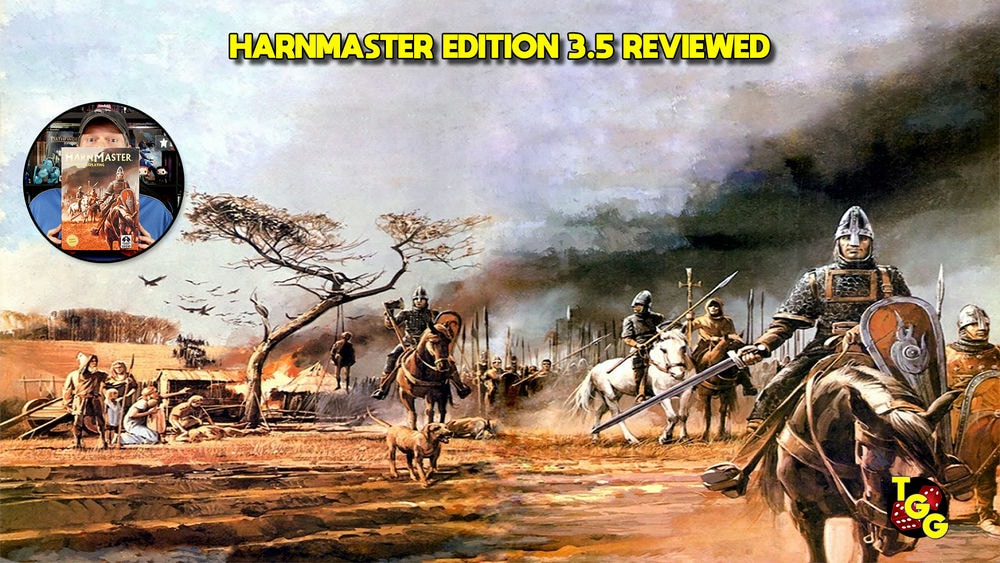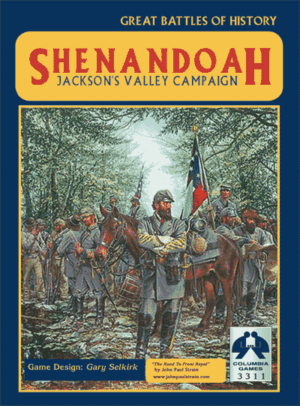
Publisher: Columbia Games
Designers: Gary Selkirk with Tom Dalgliesh
Artists: Tom Dalgliesh and John Paul Strain
Year: 2011
Genre: Two player fog of war ACW wargame
Players: Two players
Ages: 10+
Playing Time: Two to three hours
MSRP: $89.99 with mounted map ($59.99 with card map or with the mounted map if preordered)
Shenandoah: Jackson’s Valley Campaign is the latest in Columbia Games line of fog of war block games. The valley campaign, during the American Civil War, as led by Confederate general Thomas J. (Stonewall) Jackson is one still studied by historians and at war colleges around the world to this day as, over a period of a month and a half, Jackson fought and defeated three separate larger Union armies at every engagement and tied up forces that could have been sent against the Confederate capital of Richmond. Shenandoah is Columbia’s take on the action as each player takes on the role of the Confederates or the Union forces during the fighting between May and June of 1862.
For those familiar with Columbia’s previous fog of war games Shenandoah is like donning a comfortable pair of slippers as the great many of the mechanics of Columbia’s previous titles stay intact yet there are a few new wrinkles which make Shenandoah stand out from other releases. If you haven’t played one of Columbia’s game before let’s take a quick rundown of the system behind Shenandoah.
In a fog of war block game (normally a two player game) each combatant’s units are represented by wooden blocks featuring a sticker on one side which is visible to its owner but not to the opponent until it is involved in combat. This leads to the fact that you never know exactly what forces you face at any given time and neither does your opponent unless either of you meticulously pay attention once a unit has been revealed. One of the selling points of a fog of war game, that isn’t present in a traditional wargame using counters, is a sense of uncertainty of just what you’ll be going up against and this leads to much of the fun. Each block can be rotated to indicate when it is at full strength or after it has taken loses. This is known as step reduction.
Shenandoah uses a point to point system and units occupy towns as opposed to hexes. Each town is connected by a variety of pikes, roads, trails, gaps, fords, and ferries. These routes affect the number of units that can move along these paths in a given turn and some provide a negative modifier for units attacking by way of them – fords for an example. Towns may have four statuses: Friendly, Enemy, Contested, and minor towns may be neutral. Major towns, if unoccupied, are never neutral. Control of a town is extremely important as we will see.
As an interesting side note, the town of Winchester, Virginia was said to have changed hands 72 times during the period of the war and thirteen times in one day alone.
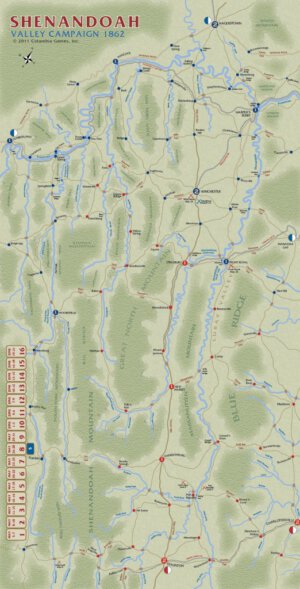
Initiative – Simply enough both players roll two dice and the high roll is the first player. In the case of a tie, the CSA player will be the first player.
Movement – The first player activates any or all Headquarters units by placing them face down on the town they occupy. This allows the player to activate units within command range (either in the same town or one which is adjacent on the map) and proceeds to move those blocks. If any units will be moved into battle or to reinforce a battle they may only move one town. If they are not looking to initiate combat, those blocks may move two. Keep in mind there are restrictions of how many blocks may move along a particular route and that number is halved if blocks are moving to the attack. An example of this is on a road eight blocks may move along it but only for what I would consider strategic movement; if they are attacking along that road then only four blocks can take that route.
HQs may only activate blocks of their own division with the exception of Stonewall Jackson who may activate any CSA block. A unit out of command range may move one town but runs the risk of losing a step and, if brought to zero, it is eliminated.
Once the first player has moved whatever blocks they choose to, they then reduce their activated headquarters units one step and move them as per the normal movement rules. This is important to remember because you don’t want to move all your blocks only to find the HQ can’t follow the troops because you have exhausted the movement limit of a route.
One interesting aspect of movement is that player one may pin an equal number of his opponent’s units if on the attack. This prevents player two from just moving units out of danger although if there are move defending blocks than attackers, the defender may move access blocks from that town during their portion of the Movement phase.
Once player one has completed their movement, player two may activate and move any unpinned HQs and blocks. Remember, the limits that apply to movement apply to both sides equally so you don’t have to worry how many opponent blocks used a particular route before you did.
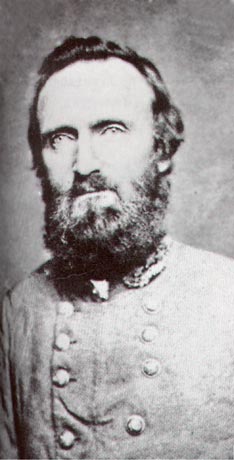
Player one determines the sequence in which battles are resolved and this is critical. Since forces cannot retreat or regroup in anything other than a friendly or vacant town, player two of that turn may be able to cut off routes of escape for their opponent. Player one finds they control the sequence of battles, but can end up with nowhere to go should things go badly. This isn’t to say that someone playing first against an unobservant opponent can’t pull this off though.
In this respect, you might decide to attack a defender who probably outnumbers you and outguns you just to contest that town in order to prevent defenders in a more important, adjacent battle from using that town as an escape route… If an attack was made by more than one route, one must be declared as the main attack and the other blocks are considered reinforcements which may not attack or defend until the second round of battle. Battles only last three rounds and, if by the fourth round the battle hasn’t been decided, the attacker must retreat. No unit may retreat during the first battle round except for cavalry.
Once a battle is joined the player who moved troops into that town is considered the attacker. All the blocks occupying that town are placed face down and revealed. A fights first, followed by B, and then C. If each side has units of the same letter rating, the defender rolls first. Each block rolls an equal number of six sided dice as they have steps and any roll equal to or less than their fire power are considered hits. To use Ashby’s Cavalry, as previously mentioned, they would fight in the B portion of the battle round and, if at full strength roll three dice scoring a hit on every one or two. Hits are scored immediately against the strongest defending unit unless the units are equal in remaining steps in which the player taking the losses determines which block or blocks are reduced.
Any block that is reduced to zero is permanently removed from the game and counted toward victory points for the opponent.
Once the second battle round begins, reinforcements may attack and take losses or units may retreat rather than roll for combat. As previously mentioned, blocks may only retreat to friendly or vacant towns and the attack limits for the routes taken will still apply; i.e. only four blocks may move along a road. Defenders may retreat into enemy major towns if those towns are vacant. If the attacker retreats they must use the routes in which they moved to the attack. Also, if the attacker is forced to retreat on round four the defender will still roll for their units in that battle round so it can be a devastation retreat in reality.
Following the battle the victor may choose to regroup and thus move any of their blocks to friendly o vacant adjacent towns. Once again the route limitations will apply to this as well.
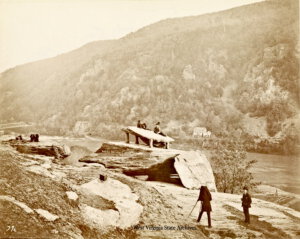
Each side now receives steps in reinforcements (USA 3 points and CSA two points) to use to replace lost steps on current blocks in play. Only one step may be replaced on a given block. To do so these blocks must be able to trace a line of supply to their particular division’s supply base. To be in good supply a route must be traced (regardless of length) though friendly towns of any type and/or vacant minor towns. If this line cannot be traced the units will still activate and fight as normal, you just won’t be able to reinforce them until they can trace that line of supply.
Both sides also may bring into play one of their free detachments to be added to their division listed as long as the town is considered in supply (a block must occupy the town receiving the detachment) and it does not violate the stacking limit.
All in all this is, for the most part, the overall gameplay outside of a few rules here and there I’m not tackling simply for brevity sake.
As most of the Columbia titles I’ve run across, I really like Shenandoah because it’s easy to get into the flow of the game but there are some deeper aspects to the game that don’t meet the eye. As the Confederates you’ll need to keep in mind your overall commander can activate any block adjacent and if Jackson were to fall command passes to Richard “Baldy” Ewell and, if need be, to Edward “Allegheny” Johnson. These leaders have an advantage over the Union Commanders because the Union can only activate blocks within that division’s command.
Those expecting to reenact Jackson’s tremendous campaign will be sorely disappointed if they play the situation presented in the rules as the game is very well balanced between both the Union and CSA. There are optional historical variants that will provide a bigger challenge for the Union player and allow a savvy Confederate player to wreak havoc along the lines of Jackson’s Valley campaign.
At the end of the day, Shenandoah should appeal to most wargamers, although some diehards may find the title isn’t as in depth as they may like. For those looking to introduce themselves, or others, to an American Civil War game that won’t take hours to learn and has much more cooking than meets the eye Shenandoah is an excellent choice to add to your gaming shelf. One issue that I do have with Columbia, and I do understand that for a company to stay in business they have to make a profit but the $30 difference between getting a mounted map and an unmounted map is really uncalled for in my opinion. I understand that if you preordered you could have received the mounted map for the regular $60 price tag. That sounds like the proper pricing for this title as a $90 tag is really too rich for my blood for what you get.
[rwp-review id=”0″]
- Outcast Silver Raiders Slipcase Set Reviewed - Nov 24, 2024
- Store Your Polyhedrals in the Dungeons & Dragons Demilich Dice Holder from Diamond Select Toys - Nov 24, 2024
- Battlezoo: Eldamon for 5E Reviewed - Nov 23, 2024






